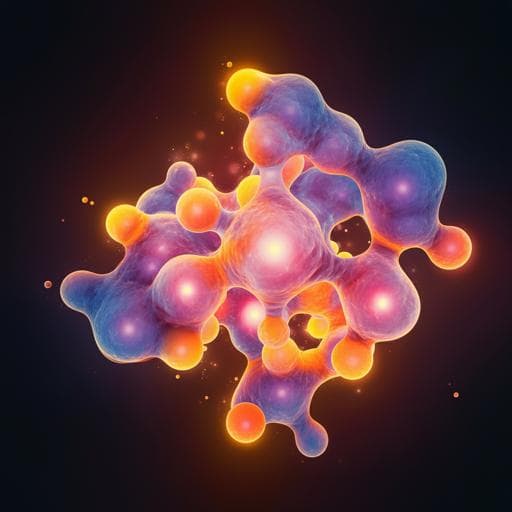
Chemistry
Beyond nothingness in the formation and functional relevance of voids in polymer films
F. C. Kalutantirige, J. He, et al.
Discover how nanovoids, often dismissed as nothingness, play a crucial role in the properties of polymer films, particularly in polyamide membranes used for molecular separation. This groundbreaking research showcases the innovative techniques employed by our expert authors including Falon C. Kalutantirige, Jinlong He, and others to unveil the complex relationship between void networks and membrane functionality.
~3 min • Beginner • English
Introduction
The study addresses how nanoscale voids form within polymer (polyamide) films and how these void networks influence solvent permeance and mechanical properties. Voids are ubiquitous across materials and scales but are difficult to image and quantify at the nanoscale due to limitations in penetration depth and spatial resolution. Polyamide membranes used in separations possess interconnected crumples and embedded nanovoids that are not fully captured by traditional 2D imaging or simpler morphometry. The authors aim to integrate 3D electron tomography, quantitative morphometry, graph theory, and coarse-grained molecular dynamics (CGMD) to (i) elucidate the morphogenesis of interconnected nanovoids and crumples, (ii) quantify their 3D structure, and (iii) relate nanomorphology to methanol permeance and nanomechanical behavior. This is important for establishing synthesis–morphology–function relationships and guiding membrane design for separations and other applications involving complex nanostructures.
Literature Review
Prior 3D imaging methods (optical, ultrasound, MRI) reveal macro/micro voids but lack nm-scale resolution and depth. X-ray tomography excels for many materials but is typically limited to tens of nm resolution for nanoscale features. TEM tomography has recently been used to resolve nm-scale morphology in polyamide (PA) membranes, including inner voids, but earlier analyses focused on simpler, spatially separated crumples rather than interconnected networks. Previous hypotheses for PA morphology formation include self-limiting flat-film formation with subsequent protrusions (possibly due to interfacial boiling, differential diffusion, or local heating), CO2 nanobubbling during interfacial polymerization (IP), and pore-mediated reaction fronts. Earlier work by the authors linked crumple wavelength to reaction–diffusion (Turing-like) instabilities governed by monomer concentrations, but did not fully account for 3D void-induced local thickness variations. Prior void characterization often relied on cross-sectional TEM/SEM, water uptake, or effective refractive indices, which could not render full 3D void shapes and connectivity. Graph theory (GT) has been applied to various nanoscale networks, but a robust pipeline connecting 3D tomography to GT metrics for soft polymer networks is lacking. This work builds on these gaps by combining tomography-driven morphometry, volume-filled 3D void reconstructions, GT-based skeleton analysis, and CGMD to connect synthesis conditions to 3D nanovoid morphology and function.
Methodology
- Materials synthesis: Free-standing PA membranes formed by interfacial polymerization of trimesoyl chloride (TMC, in hexane) and m-phenylenediamine (MPD, in water) on a polysulfone support with a cadmium hydroxide nanostrand sacrificial layer. MPD concentration fixed at 5 w/v% and reaction time 60 s. TMC varied: 0.05 w/v% (PA1), 0.1 w/v% (PA2), 1 w/v% (PA3). Control membranes without PS support were also synthesized. Apparent film height < ~400 nm.
- Electron tomography: Low-dose TEM tomography (dose rate 4–7 e− Å−2 s−1), tilt from −60° to +60° in 2° steps (61 projections). Alignment and CTF correction with IMOD; reconstruction using OpenMBIR. Voxel size 3.5 Å. 3D greyscale volumes generated for two samples per condition.
- Local thickness mapping: Defined as the diameter of the largest inscribed sphere per voxel. Tomograms thresholded and binarized; thickness maps computed (FIJI ImageJ local thickness plugin) enabling multimodal thickness distributions (t1, t2, t3) and spatial slices.
- 3D void reconstruction: Due to limited contrast between voids and background, PA material was segmented first (denoising via median, Gaussian, and edge-preserving filters; thresholding; semi-manual segmentation; binary smoothing). Void volume obtained by using segmented PA as a boundary to partition and remove background, yielding volume-filled voids. Open vs closed voids distinguished based on connectivity to the membrane undersurface. 3D surface areas of open/closed voids computed by triangular mesh.
- Skeletonization and graph theory: PA material volumes skeletonized (Amira autoskeleton, thinning) to 1-voxel-thick curves defining nodes and branches. Graphs constructed from skeletons. Computed GT metrics including graph density (ρ = e/(n(n−1)/2)) and global efficiency (E = average of 1/Lij over node pairs via shortest path distances). Counts of nodes/branches, and normalized branch lengths were also obtained.
- CGMD simulations of IP: Employed a multiscale coarse-grained model (Muscatello et al.) maintaining monomer shape/connectivity and reactive sites without explicit solvents. Simulation cell ~100 × 130 × 100 nm³ with reservoirs maintaining near-constant monomer densities; vacuum layers to avoid periodic interactions. TMC:MPD ratios investigated: 1:12.3 (matching PA3 conditions: 1 w/v% TMC, 5 w/v% MPD) and 1:4 (PA4, computationally cheaper). MPD diffusion into TMC region enabled after deactivating repulsive constraints; crosslinking triggered when reactive CG site distance < 2.375 Å. Langevin dynamics at 300 K, 1 atm, timestep 3 fs, total 600 ns. Additional simulations varied MPD diffusion rate. Output analyzed for oligomer formation, coalescence, local density, and unreacted functional group distributions.
- Methanol permeance measurements: Membranes (25 mm) soaked in methanol 24 h, tested in Sterlitech HP4750 cell. Pressurized to 150 psig at 25 psi/min, mass flow recorded to compute permeance = M/(A P).
- Permeance modeling: Spiegler–Kedem model adapted. Approach 1: incorporated multimodal local thickness (t1, t2, t3), areas of top/bottom surfaces, and 3D surface areas of open/closed voids; included degree of crosslinking (DOC) by XPS. Approach 2: used apparent AFM thickness ignoring inner voids for comparison. Model inputs summarized in Supplementary Tables.
- AFM nanomechanics: Apparent modulus mapping in air (Asylum Cypher S, AC240TS-R3 tip, k ~2 N/m). 256×256 force–indentation grids per sample; Hertz model with bottom-effect correction. Tip radius 7 nm; tip Poisson 0.17; tip modulus 150 GPa; sample Poisson 0.39.
- XPS for DOC: Calculated using established peak area relations, yielding DOC values for PA1–PA3.
- Atomistic MD for modulus: Constructed three atomistic IP models (box ~6×6×6 nm³), equilibrated; NEMD compression to 20% strain at 10^6 s−1 in NoσεT ensemble; extracted elastic moduli.
Key Findings
- 3D morphology and local thickness:
• Tomography reveals interconnected crumple networks with spanning nanovoids; crumple density increases with TMC concentration (consistent with reaction–diffusion instability).
• Local thickness histograms are multimodal with three maxima (t1, t2, t3). Values (mean ± fit error):
- PA1: t1 = 7.2 ± 0.5 nm; t2 = 17.4 ± 0.1 nm; t3 = 23.0 ± 0.1 nm.
- PA2: t1 = 6.9 ± 0.3 nm; t2 = 16.4 ± 0.1 nm; t3 = 21.9 ± 0.2 nm.
- PA3: t1 = 5.7 ± 0.3 nm; t2 = 14.4 ± 0.1 nm; t3 = 20.4 ± 0.1 nm.
• t2 ≈ 2·t1 and t3 ≈ 3·t1, indicating thicker regions arise from merging of thinner crumple walls; all thickness modes decrease as CTMC increases.
- Mechanism from CGMD and tomography:
• CGMD shows membrane formation via diffusion-driven reaction and aggregation of oligomer clusters that coalesce into a spanning network. Unreacted functional groups localize on cluster surfaces; upon coalescence, steric/stoichiometric constraints leave inter-cluster interfaces less reacted, producing voids.
• Simulated morphologies (voids, heterogeneous densities) align with experimental observations; lower amine diffusion yields denser structures.
- 3D void reconstructions and statistics:
• Volume-filled reconstructions yield complete 3D maps of open and closed voids. In a 727 nm × 727 nm projection area, as CTMC increases (PA1→PA3), both PA material volume (Vtm) and void volume (Vtv) decrease: Vtm ≈ (49.2 ± 4.0), (42.4 ± 5.7), (32.4 ± 3.4) ×10^3 μm^3; Vtv ≈ (12.7 ± 1.2), (8.7 ± 0.9), (6.1 ± 0.3) ×10^3 μm^3.
• Void ratio r = Vtv/Vtm: PA1 25.7% ± 0.4%; PA2 20.5% ± 0.6%; PA3 19.0% ± 1.1%. Void volume fraction of total (void + material): PA1 20.5% ± 0.2%; PA2 17.0% ± 0.4%; PA3 16.0% ± 0.8%.
• Lower CTMC (PA1) yields larger, more clustered voids; higher CTMC (PA3) yields smaller voids with higher crumple density.
- Permeance modeling:
• Incorporating nanovoid 3D surface areas (open/closed), multimodal local thickness, and DOC (Approach 1) provides qualitatively better fits to measured methanol permeance than AFM thickness-based Approach 2.
• DOC by XPS: PA1 97.7%; PA2 73.9%; PA3 41.8%.
- Graph theory and mechanics:
• Skeleton graphs capture 3D structural connectivity. GT metrics differ by synthesis condition and are consistent within replicates.
• Graph density ρ (×10−3): PA1 9.0 ± 0.2; PA2 1.2 ± 0.1; PA3 1.9 ± 0.3. Global efficiency E (×10−2): PA1 4.8 ± 0.4; PA2 6.1 ± 0.4; PA3 6.9 ± 0.7.
• AFM apparent moduli (mean ± SD): PA1 1.12 ± 1.38 GPa; PA2 1.51 ± 1.61 GPa; PA3 2.50 ± 1.73 GPa. Trend PA1 < PA2 < PA3 aligns with increasing E and decreasing void fraction (higher material fraction) and with GT-inferred skeleton rigidity.
• Atomistic MD moduli: 1.21, 1.48, 2.61 GPa for increasing TMC:MPD ratios, matching experimental means.
Discussion
The integrated approach reveals that interconnected nanovoids and crumples in PA membranes arise from reaction–diffusion-driven oligomer aggregation and coalescence. Tomography-based local thickness multimodality (t2 ≈ 2·t1; t3 ≈ 3·t1) directly evidences wall merging, while CGMD explains how incomplete interfacial reactions between aggregates create voids. Quantitative 3D void reconstructions demonstrate that monomer concentrations tune total void volume, void size distribution, and open/closed void topology. Incorporating these nanomorphological descriptors—3D void surface areas and spatially varying local thickness—into a transport model significantly improves permeance predictions over conventional thickness-only approaches, showing that nanoscale architecture (not just average thickness) governs solvent transport. Skeleton-based GT metrics provide a compact, system-level representation of 3D morphology; higher global efficiency and graph density correspond to more effective load transfer and increased apparent modulus, consistent with AFM measurements and porosity trends. Together, these results connect synthesis parameters to 3D nanostructure and, in turn, to function (permeance and mechanics), underscoring the central role of nanovoids in determining performance.
Conclusion
This work establishes a comprehensive pipeline—electron tomography, morphometry (local thickness and volume-filled 3D void reconstructions), CGMD, and graph theory—to quantify and interpret the morphogenesis and functional impact of nanovoids in polymer films. For PA membranes, we show that oligomer coalescence during interfacial polymerization produces interconnected void networks, yielding multimodal local thickness and tunable void architecture controlled by monomer concentrations. Including 3D void surface areas and local thickness distributions in transport modeling improves methanol permeance fits, while GT metrics (graph density and global efficiency) correlate with apparent modulus, linking structural connectivity to mechanical robustness. Future directions include: extending the workflow to other soft and porous systems (e.g., conductive polymers, MOF layers, hydrogels, biological filament networks), refining simulations to capture local thermal/boiling effects during IP, automating segmentation for higher throughput, and exploring predictive design where targeted GT metrics guide synthesis toward desired transport and mechanical properties.
Limitations
- Tomographic reconstructions, while high resolution, still rely on thresholding and semi-manual segmentation; errors in material/void partitioning can affect quantitative void metrics. Missing wedge artifacts are mitigated by MBIR but cannot be entirely eliminated.
- CGMD uses coarse-grained models and Langevin dynamics at constant temperature; local reaction heat, interfacial boiling, and explicit solvent effects are not captured. Only two TMC:MPD ratios were simulated, and timescales remain limited versus experiments.
- Apparent modulus from AFM reflects combined material and morphology effects and is sensitive to substrate corrections and tip assumptions; substantial spatial heterogeneity is present.
- Sample size per condition is modest (n=2 tomograms for key analyses), which may limit statistical power.
- DOC and other chemical heterogeneities within a sample may exist but are averaged in XPS and not fully mapped in 3D.
Related Publications
Explore these studies to deepen your understanding of the subject.







